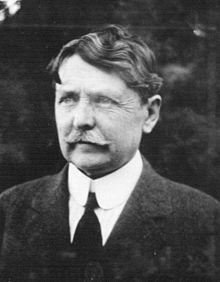- Charles Dillon Perrine
-
Charles Dillon Perrine Born July 28, 1867
OhioDied June 21, 1951 (aged 83) Nationality American Fields astronomy Institutions Lick Observatory Known for Himalia
ElaraCharles Dillon Perrine (July 28, 1867 – June 21, 1951) was an American astronomer living in Argentina.
Born in Steubenville, Ohio, a son of Peter and Elizabeth McCauley Perrine, and a descendant of Daniel Perrin, "The Huguenot", he worked at Lick Observatory from 1893 to 1909 and then was director of the Argentine National Observatory (today, Observatorio Astronómico de Córdoba) [1] in Argentina from 1909 until 1936.
Between 1900 and 1908, he accompanied four eclipse expeditions and was in charge of the one sent from Lick Observatory to Sumatra in 1901. Also in 1901, he and George Ritchey observed the apparent superluminal motion in the nebulosity surrounding Nova Persei 1901.
He discovered two moons of Jupiter, today known as Himalia (in 1904) and Elara (in 1905). They were simply designated "Jupiter VI" and "Jupiter VII" and were not given their present names until 1975.
He co-discovered the lost periodic comet 18D/Perrine-Mrkos and several other comets. Antonín Mrkos later named the asteroid 6779 Perrine after him. The lunar crater Perrine is also named after him.
He promoted the study of astrophysics in Argentina and pushed for the construction of a large telescope (the Bosque Alegre telescope), which however was not completed until 1942 (he had retired in 1936). He remained in Argentina after retirement and died there, in Villa General Mitre (which has since been renamed to its original name of Villa del Totoral). He is buried in the cementerio disidente in the city of Córdoba.
External links
Obituaries
- MNRAS 112 (1952) 273
- Nature 168 (1951) 409
- Popular Astronomy 59 (1951) 388
- PASP 63 (1951) 259
Categories:- 1867 births
- 1951 deaths
- People from Steubenville, Ohio
- American people of Huguenot descent
- American astronomers
- Argentine astronomers
- Argentine people of American descent
- 19th-century astronomers
- 20th-century astronomers
- Comet discoverers
- Discoverers of moons
- American astronomer stubs
- Argentine people stubs
- South American scientist stubs
Wikimedia Foundation. 2010.

